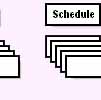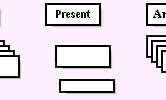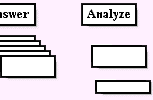| |
I wrote the TQ Questionnaire Automation system in 1984 to automate conversations.
TQ was first developed to do psychiatric interviews with touch-sensitive
screens. A patient could answer questions by touching their answers. Touching Questions.
Psychiatrists were able to create interviews which could assess the
urgency of a patient's needs.
Food companies used TQ to collect opinions and
analyze data about foods. Food testers used touch screens to give their
opinions. A facility could have dozens of terminals collecting information
at the same time. After the testing was complete, results were immediately
available.
Testing Laboratory

In 1988, part of the TQ system was adapted for a mass market.
Business Planning was chosen as the topic for
development. The DOS version of "Success Inc, the Powerful Business
Plan Writer" was released in 1989 through a publishing arrangement
with Virgin Interactive Entertainment.
In 1991, the windows version was released and "Success
Inc" was published and distributed by Dynamic Pathways Company.
Through the 90s, it was available, along with other Dynamic Pathways'
TQ-based products, on store shelves all over the world. The Russian
version of Success was part of the "parastroika" that swept communism away
with free enterprise. The TQ System helped to bring peace and
prosperity to customers everywhere.
   
The secret of Questionnaire Automation is based on a philosophy that
matches digital capabilities to the analog processes of human thought.
-
First, a Presentation (or questionnaire) is created.
It may be very simple, or use many branches to cover many possible
interactions.
It may include a series
of simple presentation screens, or it may include topics that have
interactions.
- Then, it is "Scheduled" for presentation. This can be on a
stand-alone computer, a networked computer, or through the internet.
The keyboard, touch screen, mouse, bar codes or even pencil and
paper can be used to answer the
questions.
- Presentation can be on the internet, an
intranet, or on an independent workstation. Answers can be
stored at the web site, at the workstation or on a
floppy disk. When the presentation is created or when the
respondent is presented the information, there is no need for any kind of familiarity or computer
expertise.
-
A TQ Analysis system uses
reports, statistics, and graphics to characterize the results of one or
many people's answers. Many TQ system presenters may only want
to use the system to organize and display the information. Others
may want complete analyses to determine the significance of the grouped
answers.
Best of all, the entire system, whether it was for one person or if a presentation was for a
million people, was designed to require no service. It was entirely written
by one person over 15 years. No troublesome tools were used
as a foundation of the mass produced presentation engine. All
versions are 100% compatible, so data collected from a desktop Windows
computer or on the internet could be printed, grouped or compared... even
if a survey was collected in 1986!
|
- Marketing
Compare groups statistically
- Sales
Present products and gather information from customers
- Business Planning
Shrinkwrapped products

- CRM
Customer Relations Management. Keep in
touch and even provide after-sales support automatically.
- Education
Teach and test
- Human Resources
Gather resumes and applications.
Inform employees. Interview.
- Project Administration
Track specific topics from different
workers and keep posted.
- Professional Practice
Gather information from clients and
patients, and present information at the same time. Diagnose and
Interview. Speed Paperwork.


 |

